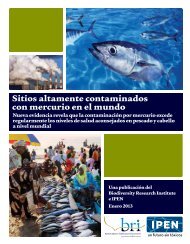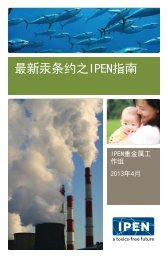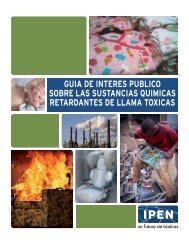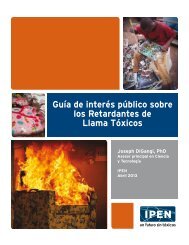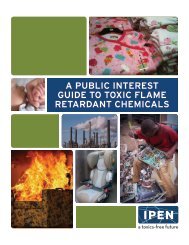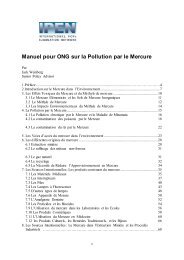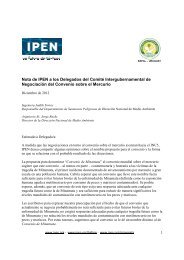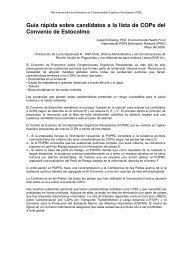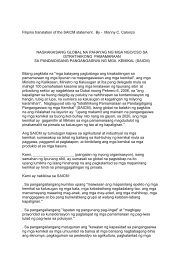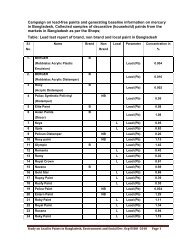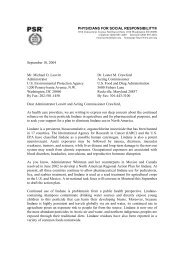The UNDP-GEF POPs Resource Kit - International POPs Elimination ...
The UNDP-GEF POPs Resource Kit - International POPs Elimination ...
The UNDP-GEF POPs Resource Kit - International POPs Elimination ...
Create successful ePaper yourself
Turn your PDF publications into a flip-book with our unique Google optimized e-Paper software.
UNEP/POPS/CONF/2<br />
Part II<br />
DDT (1,1,1-trichloro-2,2-bis(4-chlorophenyl)ethane)<br />
1. <strong>The</strong> production and use of DDT shall be eliminated except for Parties that have notified the Secretariat<br />
of their intention to produce and/or use it. A DDT Register is hereby established and shall be available to the<br />
public. <strong>The</strong> Secretariat shall maintain the DDT Register.<br />
2. Each Party that produces and/or uses DDT shall restrict such production and/or use for disease vector<br />
control in accordance with the World Health Organization recommendations and guidelines on the use of DDT<br />
and when locally safe, effective and affordable alternatives are not available to the Party in question.<br />
3. In the event that a Party not listed in the DDT Register determines that it requires DDT for disease<br />
vector control, it shall notify the Secretariat as soon as possible in order to have its name added forthwith to the<br />
DDT Register. It shall at the same time notify the World Health Organization.<br />
4. Every three years, each Party that uses DDT shall provide to the Secretariat and the World Health<br />
Organization information on the amount used, the conditions of such use and its relevance to that Party’s<br />
disease management strategy, in a format to be decided by the Conference of the Parties in consultation with the<br />
World Health Organization.<br />
5. With the goal of reducing and ultimately eliminating the use of DDT, the Conference of the Parties shall<br />
encourage:<br />
(a) Each Party using DDT to develop and implement an action plan as part of the implementation<br />
plan specified in Article 7. That action plan shall include:<br />
(i) Development of regulatory and other mechanisms to ensure that DDT use is restricted to<br />
disease vector control;<br />
(ii) Implementation of suitable alternative products, methods and strategies, including<br />
resistance management strategies to ensure the continuing effectiveness of these<br />
alternatives;<br />
(iii) Measures to strengthen health care and to reduce the incidence of the disease.<br />
(b) <strong>The</strong> Parties, within their capabilities, to promote research and development of safe alternative<br />
chemical and non-chemical products, methods and strategies for Parties using DDT, relevant to the conditions<br />
of those countries and with the goal of decreasing the human and economic burden of disease. Factors to be<br />
promoted when considering alternatives or combinations of alternatives shall include the human health risks and<br />
environmental implications of such alternatives. Viable alternatives to DDT shall pose less risk to human<br />
health and the environment, be suitable for disease control based on conditions in the Parties in question and be<br />
supported with monitoring data.<br />
6. Commencing at its first meeting, and at least every three years thereafter, the Conference of the Parties<br />
shall, in consultation with the World Health Organization, evaluate the continued need for DDT for disease<br />
vector control on the basis of available scientific, technical, environmental and economic information,<br />
including:<br />
(a) <strong>The</strong> production and use of DDT and the conditions set out in paragraph 2;<br />
(b) <strong>The</strong> availability, suitability and implementation of the alternatives to DDT; and<br />
80 ----------------------------------------------------------------------------------------<strong>UNDP</strong>-<strong>GEF</strong> <strong>POPs</strong> <strong>Resource</strong> <strong>Kit</strong>



